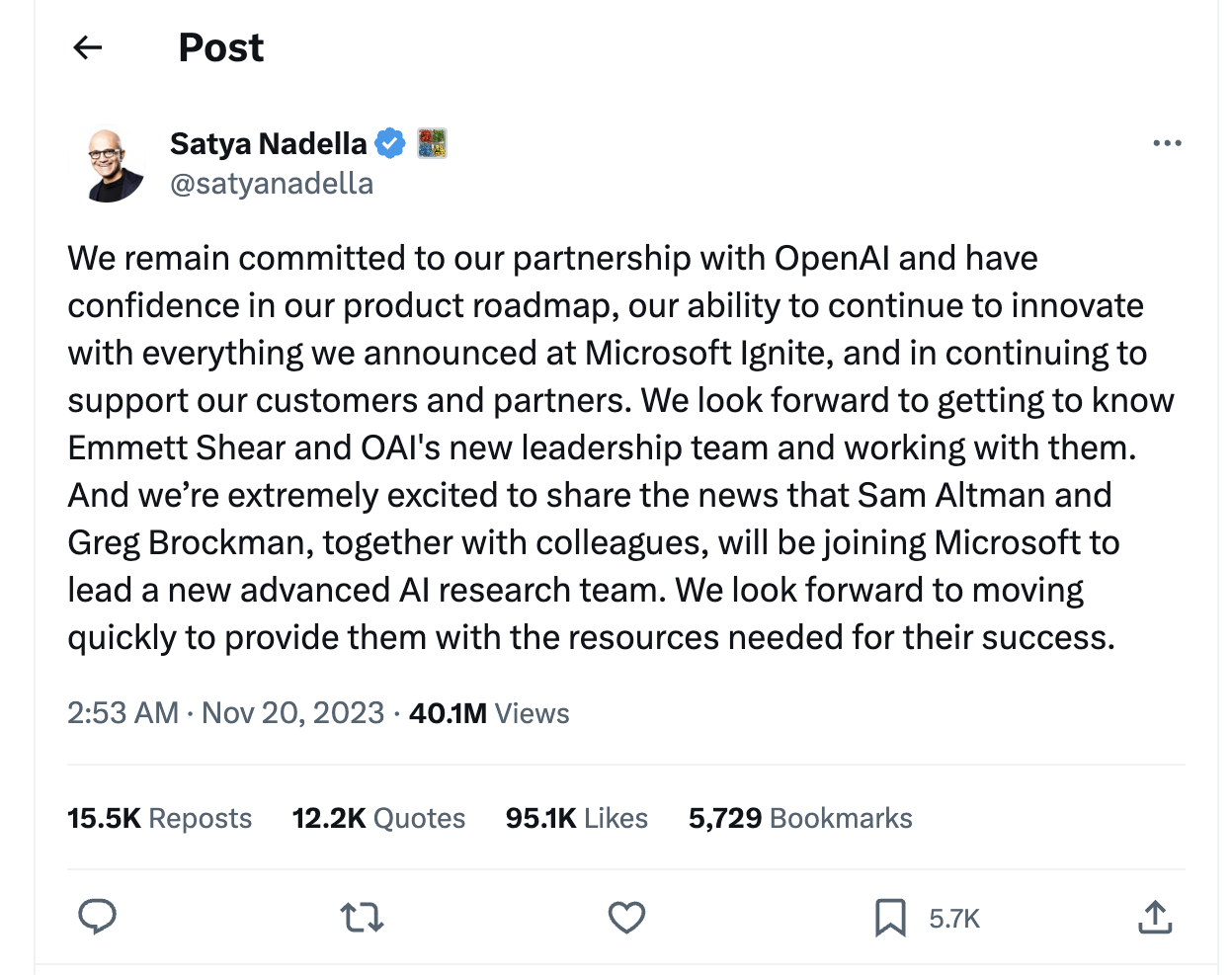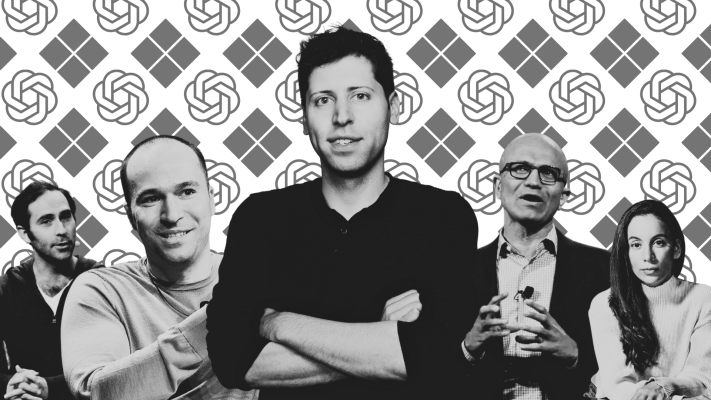In what can only be described as a rollercoaster week for OpenAI, the landscape of leadership and corporate dynamics within one of the leading AI organizations has undergone a series of dramatic shifts. The events that unfolded at OpenAI from the sudden firing of CEO Sam Altman to the intense negotiations and unexpected resolutions, have not only captivated the tech world but also raised fundamental questions about governance, innovation, and the future of artificial intelligence. This blog post chronicles a week full of suspense, strategic maneuverings, and a surprising turnaround, painting a vivid picture of the high-stakes world of AI technology companies. Join us as we delve into the intricate details of this extraordinary week at OpenAI, unpacking the events that have set a new precedent in the industry.
“It takes much less energy to move from first to tenth in a market than it does from zero to one.”
Sam Altman
November 16th
Sutskever Initiates a Pivotal Call with Altman
The seeds of the forthcoming upheaval at OpenAI were sown on Thursday, November 16. Ilya Sutskever, the chief scientist at OpenAI and a key co-founder, reached out to Sam Altman via text. Sutskever proposed a call for Friday noon, a conversation that would prove to be a critical juncture in the events that unfolded over the following week. This initial contact, as shared in a post by Greg Brockman on X (formerly Twitter), set the stage for the dramatic developments ahead.
CTO Murati Learns of Altman’s Impending Dismissal
In a significant move, Mira Murati, OpenAI’s Chief Technology Officer, was informed on Thursday night of the board’s decision to fire Sam Altman. This revelation, as alleged by Brockman, indicated that the wheels of a major leadership change were already in motion. Murati, who would soon step into the role of interim CEO, was thus made aware of the impending shift at the company’s helm, a shift that would send ripples through the organization and the wider AI community.
_
November 17th
Greg Brockman’s Sudden Demotion
Greg Brockman, OpenAI’s co-founder and president, was informed via a call from Ilya Sutskever about his removal from the board’s chairmanship, while retaining his president role. This call also revealed the firing of CEO Sam Altman, signaling a major shift at OpenAI’s top level.
Public Announcement of Altman’s Firing
OpenAI publicly announced the leadership change in a blog post, confirming Altman’s exit. This news, following internal communication, sparked reactions across the tech community.
i loved my time at openai. it was transformative for me personally, and hopefully the world a little bit. most of all i loved working with such talented people.
will have more to say about what’s next later.
🫡
— Sam Altman (@sama) November 17, 2023
Contentious All-Hands Meeting
In an all-hands meeting, Sutskever defended Altman’s ouster, stating it was crucial for OpenAI’s mission. This meeting aimed to justify the board’s decision internally amidst growing tensions.
Microsoft’s Stance on the Shakeup
Satya Nadella, CEO of Microsoft and a key OpenAI partner, released a statement affirming Microsoft’s commitment to AI innovation and continued collaboration with OpenAI under Mira Murati’s leadership.
Brockman Resigns; Researchers Follow
Brockman announced his resignation, intensifying the leadership crisis. This was followed by the resignation of three senior researchers, including the director of research, underscoring the turmoil within OpenAI’s ranks.
After learning today’s news, this is the message I sent to the OpenAI team: https://t.co/NMnG16yFmm pic.twitter.com/8x39P0ejOM
— Greg Brockman (@gdb) November 18, 2023
_
November 18th
OpenAI Board’s Deliberation and Altman’s Potential Return
In a pivotal moment, OpenAI’s board is in discussions with recently fired CEO Sam Altman about his possible return. However, Altman is reportedly ambivalent about coming back and demands significant governance changes.
A 5 PM PT deadline is set for resolving this situation, with potential mass resignations at OpenAI looming if the issue remains unresolved.
Altman’s Next Move and Employee Support
Amidst these negotiations, there’s buzz about Altman starting a new venture, possibly with Greg Brockman. Employee support for Altman is demonstrated through a coordinated heart emoji social media campaign, signaling their readiness to follow him to a new company.
i love you all.
today was a weird experience in many ways. but one unexpected one is that it has been sorta like reading your own eulogy while you’re still alive. the outpouring of love is awesome.
one takeaway: go tell your friends how great you think they are.
— Sam Altman (@sama) November 18, 2023
COO Clarifies Reasons for Altman’s Firing
OpenAI’s COO Brad Lightcap sends out a memo clarifying that Altman’s dismissal was not due to malfeasance but a breakdown in communication with the board.
Resignations of High-Level Researchers
Three senior researchers at OpenAI resign in response to the unfolding situation, indicating a ripple effect of Altman’s firing within the organization.
Investors and Microsoft’s Involvement
Investors, including Microsoft, are pressuring the board to reinstate Altman. Microsoft’s CEO, Satya Nadella, expresses support for Altman’s future steps, whether at OpenAI or elsewhere.
Board Agrees to Resign in Principle
The Verge reports that the board agreed in principle to resign and allow Altman and Brockman to return, but this decision is not yet finalized, adding to the uncertainty of the situation.
_
November 19th
Altman and Nadella’s Discussions and Uncertainties
Amidst ongoing negotiations, Microsoft CEO Satya Nadella is reportedly mediating discussions between Altman, Brockman, and the current OpenAI board members as they attempt to select a new board. Nadella indicates a desire for a resolution before the stock market opens the next day.
5 PM Deadline for Negotiations
Altman sets a firm 5 PM deadline for the day’s negotiations, indicating that failure to reach an agreement may lead to a different path and potentially extended talks.
OpenAI Employees Signal Support for Altman
OpenAI employees express their support for Altman through a widespread social media campaign using heart emojis, signaling their willingness to leave OpenAI and follow him to a new venture.
Altman’s Ventures and Negotiation Stances
Reports emerge about Altman’s plans for a new AI venture, potentially involving AI Tensor Processing Unit (TPU) chips, drawing interest from prominent venture firms and Microsoft. Altman continues to negotiate his return to OpenAI under the condition that the existing board steps down.
Board Negotiations and Leadership Dynamics
Negotiations for reinstating Altman hit roadblocks, with board members reluctant to step down. Salesforce co-CEO Bret Taylor emerges as a potential new board member.
Leadership Changes and Employee Backlash
OpenAI appoints Emmett Shear, co-founder of Twitch, as interim CEO, replacing Mira Murati. This appointment leads to a strong reaction from OpenAI employees.
_
November 20th
Altman and Brockman’s Move to Microsoft
In a surprising development, Sam Altman and Greg Brockman, along with other colleagues, announce their intention to join Microsoft, leading a new AI research division. Microsoft CEO Satya Nadella extends an open invitation to other OpenAI staff, promising ample resources for those who decide to make the switch.
 Sutskever’s Public Admission of Regret
Sutskever’s Public Admission of Regret
Ilya Sutskever, OpenAI’s Chief Scientist, publicly expresses remorse for his role in Altman’s removal in a post on X. He commits to exerting all his efforts toward reinstating Altman as the CEO of OpenAI, a significant shift in his stance.
Mass Employee Resignation Threats
An astounding number of OpenAI employees, nearly 500 out of approximately 770, including Sutskever himself, sign a letter threatening to resign. They demand the resignation of the current board and the reinstatement of Altman. By Monday, the count of signatories exceeds 650, highlighting widespread employee dissent.
Altman and Brockman’s Potential Return to OpenAI
Despite their announcement to join Microsoft, The Verge reports that Altman and Brockman remain open to returning to OpenAI. Their return hinges on the condition that the remaining board members, responsible for Altman’s initial firing, step down.
OpenAI Board Explores Merger with Anthropic
In a strategic move, OpenAI’s board reaches out to Dario Amodei, the co-founder and CEO of Anthropic, a rival AI company, proposing a potential merger. The offer, which included Amodei replacing Altman as CEO, was swiftly declined by Amodei.
_
Conspiracy or Cause? Theories Behind Sam Altman’s Shocking Ouster:
Lack of Candor and Communication Issues (Confirmed)
OpenAI’s blog post on November 17th confirmed that a significant reason for Sam Altman’s dismissal was related to issues of candor and communication. The board accused Altman of not being “consistently candid” in his communications, which played a crucial role in their decision. Additionally, Microsoft executives, key financial backers of OpenAI, expressed their displeasure at not being informed in advance about the decision to terminate Altman, highlighting the importance of transparency in such high-stakes organizational decisions{“}.
Clash Over OpenAI’s Direction (Speculation)
Speculation surrounds the idea that Altman was dismissed following a disagreement with the board about transforming OpenAI from a research-focused nonprofit into a more commercially oriented entity. This speculated strategic shift, involving product development, customer engagement, and funding acquisition for AI tools, reportedly caused concerns among board members about the potential risks associated with powerful AI {“}.
Difference in Approach to AI Safety and Deployment (Speculation)
A speculated point of contention contributing to Altman’s dismissal was the approach to AI safety and deployment. Reports suggest that Altman advocated for rapid development and public deployment of AI. In contrast, others in the AI community, including some at OpenAI, advocated for a more cautious approach, emphasizing the need to fully develop and test AI in controlled environments to ensure its safety before public release.
Speculation on AGI Achievement at OpenAI and Q-Star Learning (Speculation)
There are unconfirmed reports that Ilya Sutskever, OpenAI’s chief scientist and a board member, was concerned about the pace at which AI technologies were being released, fearing safety compromises. This comes after a day Sam Altman was reinstated back in the leadership and the speculation was that OpenAI may have made significant progress towards achieving Artificial General Intelligence (AGI). This speculation was fueled by a statement from Sam Altman, the then CEO of OpenAI, who hinted at a “massive discovery” made by the company in the weeks leading up to his firing. The nature of this discovery raised concerns among some within the organization, including chief scientist Ilya Sutskever, who was part of the decision to fire Altman. The speculation suggests that the realization of AGI, or something close to it, could have led to an ‘Oppenheimer moment’ for Sutskever, reflecting a deep concern about the potential implications and risks of such a powerful technology. In the most recent developments there was also a speculation about how they might have achieved Q-Star Learning internally, a powerful AI discovery, which they believed could threaten humanity. This AI model was claimed to be capable of solving certain mathematical problems and was seen as a step towards Artificial General Intelligence (AGI), a level of AI that surpasses human abilities in most economically valuable tasks {“}{“}{“}{“}.
Let’s take a step in understanding what is AGI and why is it a big deal and how does it differs from AI?
AI vs. AGI:
- Artificial Intelligence (AI): AI refers to machines or software that can perform tasks that typically require human intelligence. These tasks include learning, reasoning, problem-solving, perception, and language understanding. Current AI systems are mostly ‘narrow’ or ‘weak AI’, meaning they are designed for specific tasks (e.g., language translation, image recognition).
- Artificial General Intelligence (AGI): AGI represents a level of artificial intelligence that can understand, learn, and apply its intelligence broadly and flexibly, akin to human intelligence. AGI would be capable of performing any intellectual task that a human being can do, and potentially even surpassing human intelligence in many aspects. The development of AGI has significant implications, as it could revolutionize how tasks and processes are carried out across various sectors.
You can read more about it here where a user on X states how Q-Star Learning uses an advance machine learning technique called Reinforcement Learning from Human Feedback (RLHF) to adapt to more complex, nuanced tasks that are difficult to encapsulate with traditional training data.
Reactions and Negotiations (Speculation)
Following Altman’s firing, there is speculation about OpenAI staff threatening mass resignation and negotiating with the board, leading to Altman’s reinstatement. This response, along with pressure from investors like Microsoft, supposedly resulted in a board reshuffle. However, these details are not officially confirmed and remain in the realm of speculation.
Uncertainty Around Precise Reasons
While the lack of candor and communication issues are confirmed reasons for Altman’s dismissal, the exact reasons and motivations behind this decision involve a mix of confirmed facts and speculation. This situation highlights the intricate and often complex dynamics within organizations like OpenAI, particularly in the fast-evolving and contentious field of artificial intelligence.
Having delved into the complex circumstances surrounding Sam Altman’s dismissal and subsequent reinstatement, let’s now explore what this pivotal shift means for the future of OpenAI and its impact under Altman’s renewed leadership.
_
Analyzing the Impact of Sam Altman’s Return: What Does This Means For OpenAI’s Strategy and Culture
Potential Shift in Focus and Governance
Altman’s reinstatement may herald a new era for OpenAI, with possible shifts in its focus towards commercialization, alongside its ongoing concerns about AI’s potential risks. This return could lead to a stronger, more profit-focused approach, although it might also mean less risk aversion. {“}
Enhanced Partnership with Microsoft
The reformed governance structure at OpenAI is expected to be more favorable towards Microsoft. This change offers predictability and stability from a key partner in the AI industry. Microsoft’s CEO, Satya Nadella, has solidified his position as a key ally to OpenAI, supporting Altman and Brockman and ultimately benefiting from a stronger partnership with the company. There are also speculations that, with the deepening of their partnership, Microsoft might secure a position on the Board of Directors at OpenAI. {“}
Reinforced Leadership and Employee Support
Over 710 of OpenAI’s 770 employees signed a letter demanding Altman’s return and the resignation of the existing board, indicating strong support for Altman’s leadership and business strategy. This level of support, despite the polarizing circumstances, suggests a unified direction for OpenAI under Altman’s guidance. Moreover, Greg Brockman’s leadership and commitment during the crisis have garnered additional loyalty from the OpenAI employee base.
Balancing Power and Responsibility
Sam Altman’s victory in the intense five-day boardroom struggle at OpenAI has raised questions about the cost of such a win. His return, contingent on a background investigation, brings him back into a leadership role, but not without controversy and concerns. Altman’s reinstatement, following Greg Brockman’s resignation and the formation of a new transitionary board, marks a significant shift in OpenAI’s governance. However, the move has sparked debate over whether this reshuffle aligns with OpenAI’s mission of prioritizing safety and ethical considerations in AI development. {“}
OpenAI’s New Board Dynamics and Broader Implications
The composition of OpenAI’s new board, featuring figures like Bret Taylor and Larry Summers, signals a shift in the company’s strategic direction and focus. While their business acumen and connections could be advantageous, particularly in a regulatory environment that’s increasingly scrutinizing AI, there are concerns about the lack of diversity and deep AI ethics expertise. This homogenous board composition, criticized by various AI experts, raises questions about OpenAI’s commitment to a broader, more inclusive approach to AI development and the representation of diverse viewpoints in its decision-making processes.
As we bring our coverage of the tumultuous events at OpenAI to a close, it’s important to remember that this story is still developing. The recent days have been a whirlwind of change, controversy, and unprecedented twists in the world of AI and corporate governance. The return of Sam Altman as CEO, the formation of a new board, and the ongoing partnerships and negotiations with Microsoft are just the beginning of a new chapter for OpenAI. For more such content and to find out if any of the speculations and predictions made in the wake of these events come to fruition, continue following along. The world of AI is ever-evolving, and the story of OpenAI’s leadership and direction is a testament to the dynamic nature of this field. Stay tuned for further updates and insights as they unfold. And feel free to add your thoughts or comments below – your perspective enriches the conversation.
Nishit is a member of the Strategy and Analytics Department at ESM and has a keen interest in AI and Technology. He enjoys writing about the latest advancements in these fields. Discover more about his work here.




betturkey
tipobet porn
tipobet porn
Rattling superb info can be found on site.Blog monetyze
tipobet porn
Your blog is a breath of fresh air in the crowded online space. I appreciate the unique perspective you bring to every topic you cover. Keep up the fantastic work!
порно
Your post is not only informative but also incredibly engaging. I learned a lot from it.
Insightful piece
Insightful piece
Outstanding feature
Insightful piece
Al great deal for a web developer. Details: https://zetds.seychellesyoga.com/var_montero